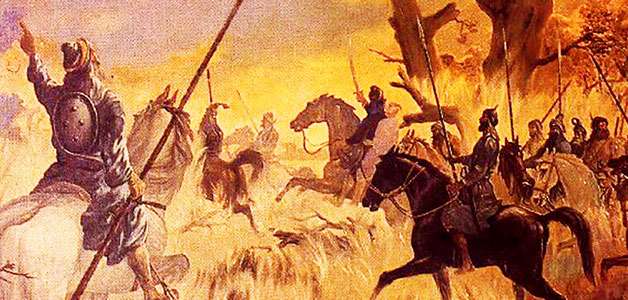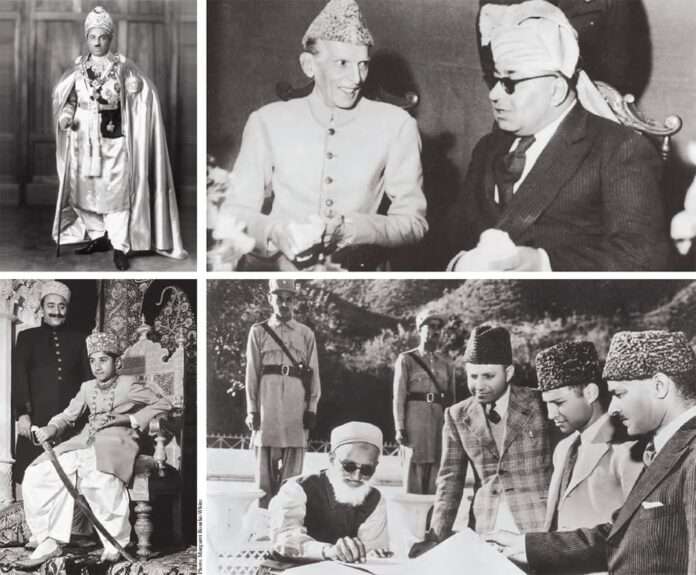Introduction
At the time of partition in 1947 there were 562 Princely States (including Agencies and Individual Residences) in India. Those States were not part of the British India because they had not been conquered or annexed by the British Government during their expansion period. What was their status?
Some salient points that were peculiar to those States are briefly being mentioned in this article for information of learned readers (particularly the young generation who may not be fully aware of the same).
Relation with the British
These Indian States enjoyed a limited sovereignty under the suzerainty of the King Emperor. The interpretation of the treaties made with these States never created any serious difficulty, for goodwill and consideration had usually characterized the relations of the Rules of the States with their Lord Paramount. The rulers of the States, in order to earn goodwill and lavish favours submitted unblemished loyalty and all out support to the British Crown during crises (war and natural calamity) by offering troops, funds, supplies, etc.
The rulers of the States used to offer their heart-felt greetings on the birthdays of the sovereign and marriages of their children and during child birth (grand children). Their greetings were often recognized with awards of honours which were proudly displayed against their names. In addition, many State rulers were bestowed with honours in Persian, legacy of the Mughals but accepted with grace and pride by the recipients. Some examples of the British and Mughal honours are appended below for the interest of readers.
- LIEUT GENERAL HIS EXALTED HIGHNESS ASAF JAH, MUZAFFER-UL-MUL WAL MAMALIK, NIZAM-UL-MULK, NIZAMUDDOULA, NAWAB SIR USMAN ALI KHAN BAHADUR, FATEHJUNG, FAITHFULLY ALLY OF THE BRITISH GOVERNMENT, GCSO, GBE, NIZAM OF HYDERABAD.
- HIS HIGHNESS FARZAND-I-KHAS-I-DAULAT-I-INGLISHIA, MAHARAJA SIR SAYAHJIRAO GAEWAR III, SENA KHAS-KHEL, SHAMSHER BAHADUR, GCSO, GCIE, LLD MAHAFAJO OF BARODA.
- HIS HIGHNESS MAHARAJA MUKHTAR-UL-MULK, AZIM-UL-IQTIDAR, RAFI-USH-SHAN, WALA SHIKOH, MOHATASHAM-I-DAURAN, UMDAT-UL-UMARA, MAHRAJA ADHIRAJA HISAM-US-SALTNT GEROGE JIWAJI RAO SCINDIA, ALIJAH BAHADAUR, SHRINATH, MANSUR-I-ZAMAN, FIDWI-I-HAZRAT-I-MUAZZAM-I-RAFI-UD-DARJA-I-DAIRA-I-INGLISTAN OF GWALOR.
- COL HIS HIGHNESS MAHARAJA SIR HARI SINGH INDAR MAHINDAR BAHADUR, SIPAR-I-SALTNAT, GCIE KCVO MAHARAJA OF JAMMU AND KASHMIR.
- LT COL HIS HIGHNESS RAIS-UD-DAULA SIPEHDARUL MULK SARMAD RAJHAI HIND MAHARAJA DHIRAJ SRI SAWAI RANA SIR UDAI BHAN SINGH LOKENDRA BAHADUR DILARJANG JAI DEV KCSI KCVO – OF DHOLPUR.
- HIS HIGHNESS AMIN-UD-DAULA WAZIR-UL-MULK NAWAB HAFIZ SIR MUHAMMAD IBRAHIM ALI KHAN BAHADUR SAULAT JANG GSCI, GCIE NAWAB OF TANK.
- HIS HIGHNESS FARZAND-I-ARJUMAND, AKIDAT PAIWAND, DAULAT-I-INGLISHIA, BABAR BANS SARMUR, RAJA-I-RAJGAN MAHARAJA PARTAB SINGH MALVENDRA BAHADUR, MAHARAJA OF NABHA.
- COL HIS HIGHNESS FARZAND-I-DILBAND RASIKHUL-ITQAD DAULAT-I-INGLISHIA RAJA RAJGAN MAHARAJA JAGAJIT SINGH BAHADUR GCSI, GCIE, GBE MAHARAJA OF KAPURTHALA.
- MAJ GENERAL HIS HIGHNESS, ALIKAH FARZAND-I-DILPIZIR-I-DAULAT-I-INGLISHIA, MUKHLIS-UD-DAULAH, NASIR-UL- MULK, AMIR UL UMRA NAWAB SIR SYED MOHAMMAD HAMID ALI KHAN BAHADUR, MUSTAID JUNG GCSI,GCIE, GCVO ADC TO HIS MAJESTY THE KING EMPEROR, RULER OF RAMPUR.
- LT COL HIS HIGHNESS SIKANDER SAULAT NAWAB SIR IFTIKHARUL MULK HAJI MOHAMMAD HAMIDULLAH KHAN BAHADUR, BA(ALIG), GCIE, CSI, CVO, RULER OF BHOPAL.
There were many more Muslim rulers who had accepted Persian honours of Mughal period.
British Resident – Administration of the States
The defence and foreign relations were controlled by the British Government. A Resident (political officer) was posted in each State to watch the interest of the British Government; they also rendered advice to the rulers on intricate matters. Most of the rulers were accorded gun salute according to their status and dignity as bestowed by the British government.
The States had been steadily adhering to type and ran the administration and land revenue system along the old lines which had come down the long centuries, lines followed by the Mughal emperors. The States had their own armies and often fought as gallant and effective allies side by side of the British forces.
Visits by British Royalties, Viceroys and Governors
The rulers often invited member of the British royalty, viceroys and governors for hunting big games and birds shoot. It was a well known fact that on the instructions of the ruler the State management would present birds with clipped wings to hamper their flight speed. Also half starved tigers, panthers and other animals would be allowed to appear in the arena of the shoots for becoming easy targets. The comfort of the visitors was ensured to the minutest details. The visitors were loaded with expensive presents.
Many rulers had been progressive and were aware that they must move with the times. They stood by their treaties. The peculiar essence of the treaties was the guarantee of protection. There was some thing of the happy family spirit in most of the States. The ruler was with his people for life, he was not a five-years bird of passage. He ate the same food, wore very much the same clothes, when he was off duty, knew their proverbs and thought the same thoughts.
Titles
The Nizam of Hyderabad was bestowed with the title of ‘HIS EXALTED HIGHNESS’ because he was the ruler of the biggest State (82698 sq miles area) and was considered to be the most loyal ally with unflinching devotion. He was known as one of the richest (come called him the richest) persons in the world. In the official banquets he was offered the first seat.
Most of the other rulers were called ‘His Highness’ whereas some rulers of the petty States were called Thakore Saheb, The Chief of Raja Saheb, Rana Saheb, Nawab Saheb, Mehter, etc. According to the list of ‘President’ most of the rulers were unauthorised Gun Salute.
Some Historical Facts of a few States
HYDERABAD
Was founded by ASAF JAH who was a leading nobleman at the court of the Emperor AURANGZEB and was subsequently appointed as Viceroy of Deccan and also held for a time the office of Wazir of the Mughal Empire. Mir Osman Ali’s two sons were married to the daughters (DURR-E-SHAHWAR and NILOFAR) of the deposed Sultan of Turkey.
During 1798 Lord WELLESLEY was appointed Governor General of India. He decided to finish the empire of Tipu Sultan. A formidable army under Gen HARRIS was collected. The strength of the Grand Army was forty five thousand, plus sixteen thousand force of the Nizam Hyderabad, commanded by Col WELLESLEY (brother of the GG) later Duke of WELLINGTON (hero of the battle of Waterloo). A large number of horses, elephants and about one lac eight thousand oxen were available in the grand army. The administrative setup consisted of one lac twenty thousand men. Also there were a great number of people following the army for loot and plunder.
Some ministers, commanders and trusted nobles of Tipu Sultan were traitors and secretly in contact with the enemy commanders. The siege of SERINGAPATAM commenced on 20 April 1799 and the enemy guns continued pounding the fort’s weak area which were being indicated by the traitors with flags. The Sultan was being kept in dark about the enemy onslaught on the outer wall of the fort. The traitors kept on informing the Sultan that the enemy attacks had been repulsed. On 4th May the enemy had captured the fort, the Sultan had embraced SHAHADAT while fighting like a lion. The soul of Tipu Sultan and of his loyal commanders would continue cursing the Nizam Hyderabad (of 1799) and the traitors till the Day of Judgment. The history has not forgiven them.

GWALIOR
It derived its name from the ancient town of GWALIOR. The word ‘Gwalior’ is the corruption of GOPADRI or GOPIGIRI, “the shepherd hill”. It is said the fort was founded from 255-282 AD. The State was under the sway of MAHADJI SINDHIA – Maratha. The subsequent rulers had fought many battles against the ROHILLAS. The State forces joined the Maratha forces concentrated for the 3rd Battle of PANIPAT in 1761 under SINDISH RAO BHAU. AHMAD SHAH ABDALI inflicted a crushing defeat on the Marathas. The ruler of the State was taken prisoner during the battle and executed. Some details of the battle will be mentioned in Part 2 of this article.
In 1784 the ruler of SINDHIA was invited to accept the Prime Ministership (AMIR-UL-UMRA) by the Emperor SHAH ALAM but he refused the honour with polite humility. The State had an area of about 26000 sq miles. On 14 November 1914 a daughter was born to His Highness by the junior Maharani. With the gracious permission of Her Majesty the Queen Empress, the princess was named MARY KAMLA RAJA. During 1916 the heir apparent was born and with the King Emperor’s gracious consent the prince was named GEORGE JIVAJIRAO SCINDIA.
JAIPUR (AMBER)
In had an area of 16682 sq miles and was considered one of the Chief among the States of Rajputana. DADU PANTHI sect (off shoot of Hinduism) was considered one of the most notable. At the Sambhar Lake was a shrine and monastery built near the spot where the founder of the faith ‘DADU’ vanished during the reign of Akbar the Great. Akbar followed a policy of reconciliation with the Rajputs, in 1562 he married the eldest daughter of Raja BHARMAL of Jaipur. Akbar’s son (SALIM later JEHANGIR) was also married to another princess of the same family – daughter of MAN SINGH (niece of Akbar’s Rajput wife) who was one of the best generals of Akbar.
JODHPUR (MARWAR)
This by far was the largest State in RAJPUTANA having an area of 34963 sq miles. It was founded by RAO JODHA. It was called JODHPUR and sometimes MARWAR. The Capital was founded in 1459 AD. The Fort is in some ways the finest in Rajputana, commands the city and stands in great magnificence upon an isolated rock, about four hundred feet above the surrounding plain. The Maharaja was the head of the Rathor clan of Rajputs. RAMA, the hero of the great Hindu epic Ramayana had belonged to the ancient Kshatriya warrior race and their kinsmen, the Sisodias of UDAIPUR belonged to the same clan. Raja UDAI Singh married his daughter with Jehangir and Emperor Akbar presented several rich districts in Malwa.
Udai Singh’s Rathore soldiers performed many signal services for Akbar the Great. His son Gaj Singh also stood high in favour of the Emperor, whose good opinion he earned by his gallantry at the storming of JALORE and by fighting against Rana Amar Singh of Marwar. He was nominated viceroy of Deccan.
SACHIN
The small, perhaps the smallest States who ruler was bestowed with the title of His Highness, was in the Bombay Presidency. Its area was 49 sq miles and contained 21 villages. The State’s headquarters of Sachin was a village about nine miles from Surat; it contained palaces and a small fort of the ruler. The ruler enjoyed a dynastic salute of 9 guns and a personal salute of 11 guns.
The rulers claimed to be MOORS (expelled from Spain) and migrated to the western coast of India. They were long known on the Western Coast of India under the designation of the admirals of the fleets of Kings of Ahmadnagar and Bijapur in the Deccan. It is possible that the deputies of the greatest Muslim Admiral BARBAROSSA had frequently carried out sea voyages in the Arabian Sea during the sixteenth century and it is likely that the expelled Moors had come in contact with the locals of the Western Coast of India. Later Emperor Aurangzeb accepted them in his service during 1660. the Peshwa (Maharatta) and the English helped them to achieve the control of the SACHIN area and accepted them to be the rulers, who claimed to be the direct descendant of the SIDI Admirals of the Mughals. SIDI ALI was one of the deputies of BARBAROSSA.
(To be continued)




